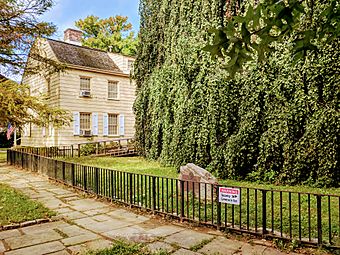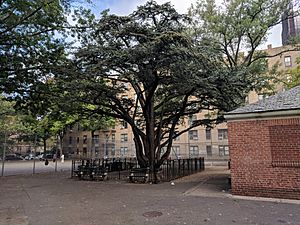Weeping Beech (Queens) facts for kids
|
Weeping Beech
|
|

Kingsland Homestead and the Weeping Beech
|
|
| Location | 37th Av. and Parsons Blvd., New York, New York |
|---|---|
| Area | less than one acre |
| Built | 1847 |
| NRHP reference No. | 72000905 |
Quick facts for kids Significant dates |
|
| Added to NRHP | May 31, 1972 |
The Weeping Beech was a very special tree in Flushing, Queens, New York City. It grew in a place called Weeping Beech Park. This tree was known as the "mother" of all European weeping beeches in the United States. This means many other weeping beech trees in the country came from it.
A plant expert named Samuel Parsons brought the tree to America in 1846. It was planted in 1847. The Weeping Beech became a special New York City Landmark in 1966. It was one of only two trees in New York City to get this honor! In 1972, it was also added to the National Register of Historic Places, along with the nearby Kingsland Homestead. Sadly, parts of the Weeping Beech tree were removed in 1998.
The area around the tree, called Weeping Beech Park, is a cool place to visit. It has a playground, the Kingsland Homestead, the John Bowne House, and other old and important trees.
The Weeping Beech: A Special Tree's Story
Samuel Parsons was a nurseryman, which means he grew and sold plants. He helped plant Central Park in Manhattan. In 1846, he traveled to Belgium and found a special tree cutting. This cutting came from a tree on Baron DeMann's estate. Parsons brought it back and planted it in Flushing in 1847.
Parsons also started a plant nursery in Queens in 1868. This nursery later moved to Kissena Park. It became a very important part of Flushing's plant-growing business. The nursery closed in 1901.
In 1966, the Weeping Beech was officially named a New York City landmark. At that time, the tree was huge! It spread out about 85 feet (26 m) wide and stood 65 feet (20 m) tall. Its trunk was about 14 feet (4.3 m) around. The Weeping Beech was one of only two trees in New York City to be named a city landmark. The other was a magnolia tree in Bedford–Stuyvesant, Brooklyn.
Exploring Weeping Beech Park
Weeping Beech Park was created in 1945. It was made to protect the John Bowne House, which became a museum in 1947. The Bowne family lived in this house for many years until 1945. It is said that the Bowne House was a stop on the Underground Railroad before the American Civil War. This house is also on the National Register of Historic Places and is a New York City landmark.
The park is also home to the Kingsland Homestead. This house is named after a sea captain named Joseph King. In 1923, the New York City Subway's Flushing Line was going to be extended. This meant the Kingsland Homestead had to be moved twice to keep it safe. The second time, it was moved to Weeping Beech Park. The Homestead is also on the National Register of Historic Places and is a New York City landmark. It became a museum in March 1973 and is where the Queens Historical Society is located.
The park has a playground that is about 1.3-acre (0.53 ha) big. It was rebuilt in 1956. You can also find a group of weeping beech trees in the park. These trees are descendants of the original Weeping Beech planted in 1847. Near them, there's a rare Golden Larch tree on 37th Avenue. A large Cedar of Lebanon tree stands in the playground. Two other big trees next to the park are a 49-inch (1,200 mm) wide Northern Red Oak and a 50-inch (1,300 mm) wide White Oak. Both of these trees are over 80 feet (24 m) tall!
The End of the Tree and Its Legacy
The Weeping Beech started to get sick in the late 1960s. People tried to help it by giving it fertilizer, but it didn't work. By 1998, the New York City Department of Parks and Recreation announced that the Weeping Beech had died. The city's parks commissioner even held a "funeral" for the tree in December 1998.
In March 1999, it was decided that a 10-foot (3.0 m) section of the tree's trunk would stay in the park as a memorial. By then, many trees that came from the Weeping Beech had been planted all over the United States.
The rest of the tree was given to artists. They used the wood to create sculptures and benches for a special heritage trail in downtown Flushing. A teacher from Flushing High School, Margaret L. Carman, came up with the idea for this trail. The park entrance at Bowne Street has a green area named after her to honor her great idea.



